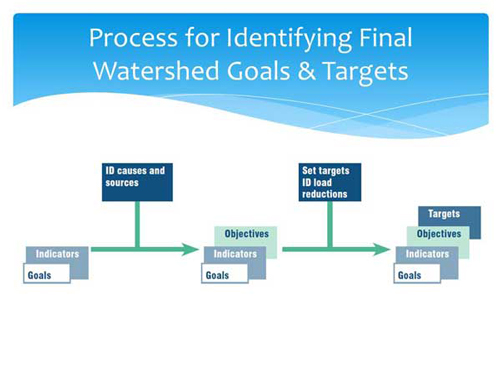Step 3: Finalize Goals and Identify Solutions
Setting Goals and Management Objectives
Now that you have characterized and quantified the problems in the watershed, you’re ready to refine the goals and establish more detailed objectives and targets that will guide developing and implementing a management strategy.
The process of developing specific objectives and targets is an evolution of the watershed goals you previously identified with your stakeholders. As you proceed through the watershed plan development process, you will gain more information on the watershed problems, water body conditions, causes of impairment, and pollutant sources. With each step of the process, you can focus and better define your watershed goals, until eventually you have specific objectives with measurable targets.
The first step is identifying the broad watershed goals with your stakeholders, answering “What do I want to happen as a result of my watershed plan?” As you do this, you will also identify environmental indicators that can be used to measure progress toward meeting those goals. Once you have identified the sources contributing to watershed problems, you can refine your watershed goals and develop management objectives targeted at specific pollutants or sources. The management objectives identify how you will achieve your goals. It is important to have indicators that can be measured (e.g., load or concentration) to track progress toward meeting those objectives. You should link some of these indicators to pollutant sources based on their cause—and—effect relationship to then identify the load reductions needed to meet the target. For example, in-stream levels of dissolved oxygen can be linked to nutrient loads, and you can use various methods to determine what reductions in nutrients will result in the dissolved oxygen target.
The next step will be to translate your watershed goals into management objectives that focus on specific processes that can be managed, such as pollutant loading and riparian conditions. For example, if one of your preliminary goals was to reduce flood levels, the specific management objective associated with that goal might be to minimize flooding impacts by improving peak and volume controls on urban sources and retrofitting inadequate road culverts.
When setting goals and management objectives for your watershed plan, be sure they are:
- Achievable
- Can you realistically reach these goals within your time frame?
- Financially viable
- Do you have the financial resources to support all of the activities needed to reach your goals? If not, you should develop a funding plan. See EPA’s Sustainable Finance Tools website.
- Technically viable
- Do you have the technical capabilities among the members of your team to complete the activities needed to reach your goals?
- If not, do you have the financial resources to outsource some of the more complex work?
- And most importantly are you goals....MEASURABLE!!!
- Have you designed your goals (and supporting activities) in such a way that they are measureable?
- Do the metrics you have designed provide you with the types of information you need to determine whether your program is successful?
![[logo] US EPA](https://www.epa.gov/epafiles/images/logo_epaseal.gif)






